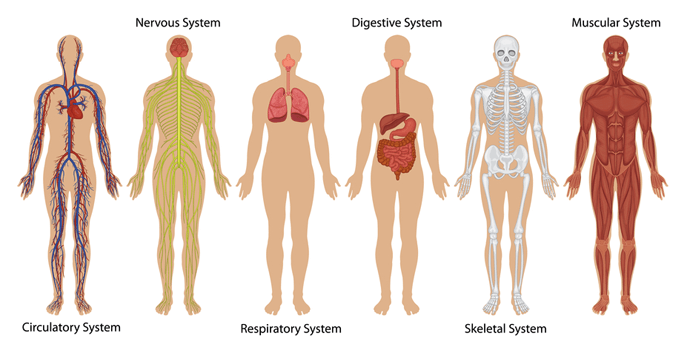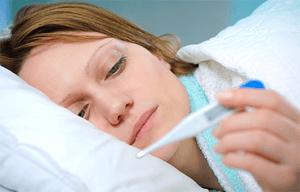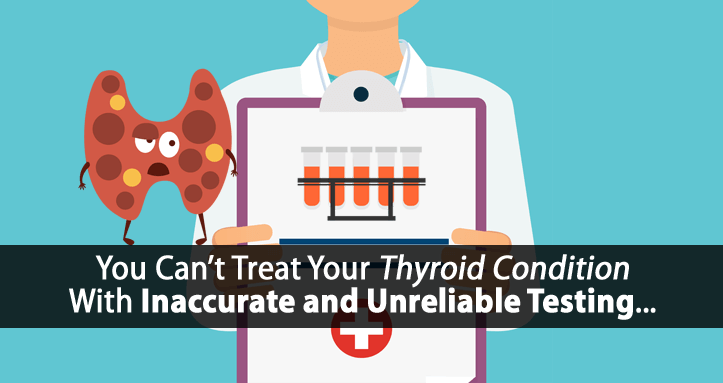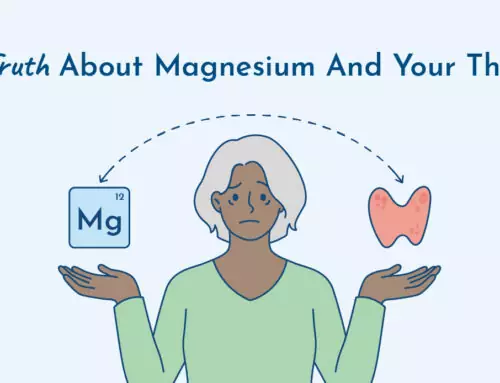Looking for the best way to test your thyroid?
Then you’re in luck.
I’ve already covered the many reasons Why (Almost) All Thyroid Tests Are Unreliable and why you CANNOT rely on them to accurately diagnose hypothyroidism or to even monitor your thyroid function.
The good news is that there’s a better way and it’s actually quite simple.
I’m going to share with you how I work with my clients using the best thyroid test.
With the billions of dollars invested each year in medical research and the amazing advancements in medical technology, you would think that the current medical system would be able to diagnose hypothyroidism today with 99% accuracy.
Heck, I’d even settle for 85% accuracy but they’re still missing that mark by a long shot.
In the Ultimate Thyroid Testing Protocol, I show you exactly why this is and how you can test your own thyroid health far more accurately without it ever costing you a dime. And it gets far more advanced than what we cover in this article.
You can download this protocol here.
Let me tell you, computer technology today may be advancing at light speed today.
Yet when it comes to healthcare, it’s ignorance that tends to impede progress.
How is it that we are told that running is the best way to burn calories and lose weight yet Russian scientists have shown that you can burn just as many calories, or more, by simply walking for the same amount of time?
Sounds crazy, right?
I’ll tell you more about that later.
In the same respect, it’s ignorance that allows us to continue to rely on inaccurate thyroid testing while ignoring a simple test that was developed 70 years ago to more accurately diagnose hypothyroidism.
Low Body Temperature and Hypothyroidism
Low body temperature is an epidemic problem.
I have personally talked with nurses and have heard stories from others in the medical field who chart temperatures all day long and who openly admit that it’s rare to find anyone today with a 98.6°F temperature unless fever is present.
Low body temperature is more often than not, an indicator of hypothyroidism.
Am I saying that everyone today is hypothyroid?
Of course not, but it’s well known that hypothyroid people get sick more often and are far more likely to develop health complications and disease.
So, it should be understandable that the majority of people being seen in hospitals and doctors’ offices for health problems today are far more likely to be hypothyroid.
Your thyroid is responsible for controlling and regulating a large number of functions within your body including:
- Metabolism and Heat Production
- Circulatory System and Blood Volume
- Muscular Health
- Nerve Health
- Digestive Health
- Health of Every Organ
- Health of Every Tissue
- Health of Every Cell

But today, we don’t even stop to consider the potential impact that thyroid health has on every function of the human body, and instead we only focus on its impact on our metabolism and our ability to lose weight.
Every cell in your body relies on thyroid hormone to produce energy and remain healthy.
When your cells use thyroid hormone they produce more energy and therefore more heat.
When your cells are starved of thyroid hormone, they produce less energy and therefore less heat.
By simply measuring the heat that your cells, or body, produce at rest can give you direct insight into how much thyroid hormone your cells are actually using.
And as I’ve mentioned many times before, TSH tests, blood tests, and all other thyroid tests DO NOT tell you how much thyroid hormone your cells are actually using, which is the only true way to accurately diagnose hypothyroidism.
The Basal Body Temperature Test
The basal body temperature test was first pioneered by Dr. Broda Barnes who was one of the early American physicians to recognize that hypothyroidism was being severely undiagnosed by modern medicine.
He spent more than 50 years researching and proving that hypothyroidism was the underlying cause of heart disease today.
Even though nobody has been able to invalidate his research, his work has been, and continues to be, completely ignored by the medical community today.
In 1942 he published a study demonstrating the effectiveness of basal temperature in diagnosing hypothyroidism and its ability to prevent wrong diagnoses that have led to unnecessary operations to remove the thyroid gland which can lead to severe health complications.
BASAL TEMPERATURE VERSUS BASAL METABOLISM
http://jama.jamanetwork.com/article.aspx?volume=119&issue=14&page=1072
SUMMARY 1. From a study of over 1,000 cases the results indicate that subnormal body temperature is a better index for thyroid therapy than the basal metabolic rate. 2. The differential diagnosis between hypothyroidism and hyperthyroidism is sometimes difficult. In 7 cases reported the diagnosis was wrong, in 5 of which an operation had been performed. The temperature was subnormal in each case.
How to Take Your Basal Body Temperature
 Caution: This is a complex medical procedure that should only be carried out by highly trained medical professionals. You are not a doctor and have not gone through 10 plus years of medical training required to accurately read a thermometer and diagnose hypothyroidism. This test is contraindicated by poor eyesight which may lead to false readings. (Just a little thyroid doctor humor.)
Caution: This is a complex medical procedure that should only be carried out by highly trained medical professionals. You are not a doctor and have not gone through 10 plus years of medical training required to accurately read a thermometer and diagnose hypothyroidism. This test is contraindicated by poor eyesight which may lead to false readings. (Just a little thyroid doctor humor.)
Now that our fancy medical disclaimer is out of the way and all kidding aside, here’s how simple it is to measure your basal body temperature:
How to Measure Your Basal Temperature
- Get a thermometer and put it within arm’s reach by your bedside at night before you go to sleep. If using a mercury thermometer, be sure to shake it down.
- Go to sleep and avoid eating anything in the middle of the night as digestion can affect basal metabolism.
- Upon waking in the morning, being as still has possible, reach for your thermometer by your bedside and sit completely still in bed while you take your temperature for 10 minutes. If using a digital thermometer, it’s best to leave it in your mouth for 10 minutes, prior to turning it on for most accurate results.
How to Interpret Your Basal Temperature
Men and post-menopausal women can take their basal temperature on any day.
However, women who are menstruating will notice that their temperature will fluctuate depending on what part of their cycle they are in.
During the first half of their cycle, their temperature will be lower.
During the second half of their cycle, their temperature will be higher.
Menstruating women should measure their basal temperature on days 2 through 4 of menstruation.
A healthy functioning thyroid will consistently maintain a basal body temperature between 97.8 °F (36.6 °C) and 98.2 °F (36.8 °C) upon waking.
Anything lower than 97.8 °F (36.6 °C) implies that at complete rest, your cells are not able to produce adequate energy to meet the energy demands of your body.
This would indicate that you are in fact hypothyroid.
Extraneous Influences on Basal Temperature
I’ve mentioned before that while basal body temperature is a more accurate indicator of hypothyroidism than blood testing, there are extraneous influences that need to be accounted for which can influence the results of the test.
Influence of Air Temperature
The colder the air temperature, the harder your thyroid has to work to maintain your body temperature and the warmer the air temperature, the less it has to work.
If the air temperature is relatively warm then your thyroid will have to work very little and therefore your basal temperature may appear higher than it truly is.
Influence of Infection
Oral temperature can be used but it’s well known that even the common sinus infection can falsely raise oral temperature.
If there’s any possibility of infection, then it’s best to use underarm temperature instead.
Extraneous Influences
There are many other extraneous influences that should be considered as well.
For example, sleeping under an electric blanket will artificially increase your body temperature.
Artificially raising your body temperature through exercise or even a hot bath can also influence results.
The Importance of Your Pulse
Today, we can do better than just basal temperature.
Because there are various extraneous influences that can affect body temperature, it’s important to also monitor your pulse as an additional indicator of thyroid function.
 Even if basal temperature is normal, if your pulse is below 80 to 85 beats per minutes, then this is yet another indicator of hypothyroidism.
Even if basal temperature is normal, if your pulse is below 80 to 85 beats per minutes, then this is yet another indicator of hypothyroidism.
All of my clients track both temperature and pulse which we use to decipher what is happening within the body on a hormonal level, which then tells us what we need to do in order correct the underlying problems that are inhibiting their thyroid.
If you’re not tracking your basal body temperature regardless of whether you’ve been diagnosed with hypothyroidism or not, then you need to start now.
Basal body temperature is the best thyroid test and can give you a lot of insight as to whether you are truly hypothyroid even if other thyroid tests say you’re not.
For those who are currently taking thyroid medication, it can also be very useful in determining whether, or not, your medication is working for you.
So there you have it!
Now that you know how simple it is to monitor your temperature and pulse, it’s time to take this testing to the next level.
Observing basal temperature is a great start but this test has been improved upon to make it far more accurate.
I’ll walk you through our more advanced and comprehensive testing protocol with this free training series called the Ultimate Thyroid Testing Protocol.
You can access this training for free by clicking here.








wonderful info – thank you!
very informative…will start tomorrow morning..
Your information is so very helpful. Just as you say…my tests for years have come back just barely in the “normal” range, so nothings ever been done. However, my temperature hasn’t been 98.6 in 40+ years and my pulse rate is very low too…usually in the mid 60’s to mid 70’s. No wonder I just drag around.
Your article is very enlightening. I began thinking that my thyroid physical activity was suspect. I have been through all the testing and received the results that you have indicated. When I was much younger, my mother had the radio active iodine process which destroyed her thyroid and she had to take medicine continually after that until her death. You speak of body temperature and pulse rate in the above article. In the winter I am always cold but now in warmer weather, even at my age, I am always sweating, as if I am still in my menopause state. My pulse rate is usually in the 70s. .I am hoping that the information I have ordered from your company can help me to get past this point in my quest for better health.
I’m very very optimist about having a healthy and functioning thyroid again . . . thanks to your passion and commitment for the holistic approach! The Revolution Manuel and additional materials provided are well written and comprehensible. I’ve only just begin, but sincerely convinced that this program is the answer to my prayers and my health!
Thank you Tom!!!
Yes,
They both apply to me. I have a low body temperature, and my pulse is around 64 in the morning. I just took my pulse at 9:30pm and it’s 74.
After 30 years of stressful teaching I ended up in the out of range area. I got on thy. meds, but they put me up to 2 grains too fast, and my heart starting beating too fast. The doctor that took me off the meds said, I was just a little out of range. Since then… for a year I have been on nothing.
Should I give the desicated thy. a try again, or the regular stuff? Thanks… I want to read your info again, and it may have jumped off my computer. Can you resend it? Tks.. :)
What happens when you have been asleep for 2-3 hrs and then have to go to the bathroom. Do you take your temp then or wait until morning?
I am doing this well now. At first I would forget until I put the thermometer where my eyeglasses and clock are. This program is not hard after we form new habits. Thanks for every email reminder!
I REALLY appreciate this info! I knew something was seriously wrong and nothing I was trying was working. But now I can see what the problem is and what the solution is. I think it is very smart to make sure we take our temps and pulses. Then we will have empirical evidence of improvements!
Thank you for this wonderful information, Tom! Question: I was a long-distance runner in high school college. One thing we always did was take our pulse. Our goal was a resting pulse of 60 beats per minute or under, as I was told that this indicated extreme fitness..i.e., our heart did not need to work as hard to pump blood. So does the goal of 80 or more beats per minute make sense in this case? I just found out that I may have hypothyroidism and would like to know! Thanks, Jen
That is one of the big exercise myths that has debunked. It’s common for endurance athletes to have a slow pulse and because we believe that all athletes are healthy, someone without an understanding of physiology made the incorrect assertion that a slow resting pulse must be healthy. From a physiological perspective, we rely on our heart to deliver not only oxygen but thyroid hormone, other hormones, and nutrients to our cells. A slow pulse means your cells are getting fewer nutrients and that does not support your health.
Yes, when I was in High School I too was a Long Distance runner and was told that a low heart beat was what you looked for.
i found this so very interesting….i was diagnosed with Hypothyroidism…..and was prescribed 50levo..each day…
i still have most of the the symptoms….but nobody will listen to me……yet reading your article…i found the part about pulse very enlightening…why ? because when ever any medical professional takes my pulse…..they cannot find it……the old joke about me really being dead…is beginning to wear a little thin…..while no one has ever told me …why ..why is my pulse unfindable….
i also got diagnosed with polymyalgia rheumatica…they say the thyroid problem and the polymyalgia are related…..but never said how…..i feel dreadful most days……and nobody really listens…..and i have extreme problems with the right side of my body…fluid retention…my weight has ballooned to nearly 3 times my normal weight….and all i get is….diet…eat proper….to which i think…i give up…..
Very good information. It helps us.
This is awesome info. I wish I’d known this stuff back in 2004 when I was first diagnosed hypothyroid – its hereditary on my mom’s side – hers was removed when she was 31 and I just turned 40. When my nodules were discovered I thought I had a thyroid problem all along actually and the nurse practitioner who sent me to get scanned being a thryroid patient herself along with the radiologist told me that I had probably had a bad thyroid for several years prior to being diagnosed. My sisters from my mom both have thyroid problems, one of which has it as bad as me. I have a 17 yrs old cousin on my mom’s side who just had to have his thyroid removed because it was not only enlarged, but calcified. Actually he had to have his thyroid removed along with some of his lymph nodes.
what nutrient supplements do you recomend, i have had a heavy metals checked. do you look at peoples test results if you are asked too, and do you make any recomendations .
I do look at test results when working with clients.
After a dental procedure with anaesthetic I spent three days with the heater on, and from curiosity took my morning temperature. After 5 consecutive mornings of 34.4C I made an appointment with my then GP – who told how the oldies from the retirement home his hospital serviced during his residency often kicked their bedding off and would present with temperatures almost as low as mine, and most were ok after standard warming procedures. The season was WARM and he thought I was suffering overexposure hypothermia?! I have changed GPs since, but still no-one who will look further than TSH.
Thank you for all that you do. I am wanting to learn more from you. I have suffered for years. I ended up having a ana flaxia and was in the hospital, only to not have any answers. I was told that I had an autoimmune disorder, and I would continue to have secondary issues. I was diagnosed with Hasamoto’s when I was 23. I had a third child at the age of 42. I when done with breast feeding went into a hormonal tailspin. Hair loss, memory loss, itchy skin, low sex drive, weight gain, poor bowel movements, head aches, hives, joint pain, no energy and so much more.There has been no help from the medical field. I have and continue to read everything you have to offer. I want to learn more. Everything you talk about has been working for me, I am so thankful to be headed in the right direction. My Father Died 9 years ago form all of the things that I now am suffering from, and it scares me. I want to learn more. I ordered some of the products that you recommend and I am unclear as to how to take them and when? can you help? I take Synthroyd and Doctors just say everything is normal? It is not. I feel better than I ever have now that over a period of the last 6 months I have been listening to you and trying the things you suggest. I am wanting to learn more. I have a 7 year old and I am wanting to change.
The issues after breastfeeding were likely due to the rise of estrogen afterwards as estrogen is suppressed during lactation. If you’re referring to products from the HR Program, then be sure to check the program supplement guide as it covers most everything there. And send me an email if you’re still confused about anything.
I have always had low heart rate, low blood pressure,low cholesterol,fool the cold terribly!!!!
I have been diagnosed with a low thyroid/ now on thyroxin. Have had a heart attack.
In January this year I had open heart surgery/ double by pass surgery.
What can I do now ?
Where do you have rooms?
Hi there. I have been Hypo since 1995. For about 5 years I have been on 112 mcg. Levothyroxine. 2 months ago I told my doc i still had all the symptoms as if i werent taking meds. He took my tsh since I was due for the bloodwork. He did the whole thing. He ended up lowering my dose to 100mcg. As you can imagine, I am not feeling well.
Im glad i came across your fb page. I had already been looking at the holistic approach for it because it has helped my sister with Lyme. Your 3 step protocol sounded so rediculous i figured it should work. I d like to find out more as to why and how it works. You skim the surface. Also, adrenals play a roll too.
Im not sure why but doctors around here just dont do anything with what you are addressing here. They arent helping. Im 42 and want to feel well. ?.I would love to become a success story and tell others. How can i if i dont know for sur? Do you have any web sites that address more into what you are sharing with us?
Thank you for listening and hope to hear from you!
Ps…Armour? My doc wont let me try it…why would that be? you recommend it?
I would recommend reading through some of the other website articles to learn more. Tomorrow, I’m hoping to post a comprehensive article on thyroid medications, which would discuss why many doctors frown upon it. Long story short, they are uneducated about how to use it or the benefits. But even Armour isn’t right some people and has it’s own issues.
As for adrenal fatigue, it’s related directly to thyroid issues. And the term adrenal fatigue is quite the misnomer because your adrenal glands don’t actually fatigue. Dr. Hans Selye showed this in his endocrine research.
I’ve finally gotten my temp in range after being on Armour and a paleo diet for sometime, however my pulse is either in the 70’s or near or over 100!. What would cause this and what can I do about it?
It’s important to look at temp/pulse at certain times of the day, i.e. after breakfast vs. waking. This will help rule out the stress response’s affect on artificially elevating body temperature. When pulse jumps to 100+, it can be from effects of excessive adrenaline released in response to functional hypoglycemia. This is why paleo type diets are not generally great for proper thyroid function.
This so describes me but all the test done by my doctor show nothing. I’m so ready to give up. Too tired to function. What is available out there to help.
Hi Jean, send me an email to support and I’ll send you our testing protocol.
I’m too warm but feel lousy when I’m mid range. TSH usually runs around .3 – .5. I had/have hashimotos (that’s up for debate depending on which doc I ask) and had my thyroid removed 6 years ago. Now take .175 of Levo. I did ok for the first few years but just can’t get my mojo back recently. Tom do you have any articles for people that have to totally rely on thyroid hormone replacement ?
Hi Kathy, thanks for reading. I have an article series where I discuss thyroid hormone replacement in more detail here: https://www.forefronthealth.com/thyroid-medication/
How does this all relate to hysterectomy ? Meaning, I’ve been diagnosed hypo and Hashimotos, through blood ( high antibodies) but also had to have a total hysterectomy last year due to severe endo, cysts, fibroids, hemogenomia, swollen uterus and so much more. I was obviously estrogen dominant but no one told me …..now I’m in hell trying to figure out this thyroid stuff . Wondering how all your advice applies to complete and radical hysterectomy women?? Low heart rate all the time, low temp but having hot flashes terrible…so hot and cold at same time and simultaneous….its excessive/severe and enough to make a person crazy. Would love to hear if this advice/diet/suggestion apply to a situation like this? I would consider a private consult with you as well. Thx
Yes, those are all signs of estrogen dominance prior to your hysterectomy but the hysterectomy itself really creates an estrogen dominant environment. Progesterone is produced predominantly by the ovaries and a small amount by the adrenal glands (but not in adequate amounts through the adrenal glands alone). Even though estrogen is produced during ovulation, it can also be produced in significant amounts via the aromatase pathway, which is why many menopausal women still become very estrogen dominant. What we teach applies 100% because estrogen dominance is an inherent problem among hypothyroidism sufferers. This is something that can be discussed in a lot more detail via a consultation.
Ive had hashimotos hypothyroidism for 22yrs now. Most of which my levels never were better that dangerously low. Unseen before by my gp & specialists from flinders medical ctr. i show non of the symptoms i should,almost the opposite….ALMOST. I feel the symptoms in my mind yet dont show them. i stopped my meds 10yrs ago because dr said a slight improvement in results was noted after a dosage increase…..BUT id stopped my meds a yr prior and never told doc. So……….. how could this be? Well i told myself never would i rely on something to warrant feeling better than be stuck on it for ever, losing that tiny part of ones self. so i pushed myself to try going that bit further or harder to all that i do in life, just to see for myself if indeed believing that someones words could change the inner belief of who i thought i was thus my life not to be mine anymore…. NO WAY. SUNNY DAYS FOLLOW THE RAIN always and we know rain is apart of mother natures make up. WE ACCEPT IT then it never affects us as it once did. NEVER WAIT FOR THAT ONE PERFECT FEELGOOD DAY….TAKE EVERY DAY AND MAKE THEM PERFECT. JUST BELIEVE & TRUST IN YOU INNER STRENGTHS…… your a true wonder of endless possibilities.Just believe……I DO. Signals from thyroid to Pituitary Gland & vise versa were being blocked somehow so my body was unaware of what should of been doing. Wee i am that something blocking the signals…… PLEASE you dont have to be feeling the way your being told you should be. Why would you want to right? WELL DONT. START RIGHT NOW OK…..PROMISE yourself. YOU OWE it to that beautiful real you trying to get out. Enjoy you new lives my friends. Your all now the better a part of mine. “forever in a day”
I am 42 and in May I was diagnosed with hypothyroidism. I started out back in May with Levothyroxine, then switched to Synthoid, same dose, to see if my fatigue got any better.No, it hasn’t. My levels are back in normal ranges, but I’ve gained about 20 pds and some days I am beyond tired. I do have Type 1 diabetes, which my Hemaglobin A1c is a 6.3. I also have mild spastic cp, with leading close to a normal life. Married, 2 elementary aged children and I am in college as well. I finished my 2 classes this semester, but some days, I was very fatigued, and not because of my sugar. I am very proactive about taking good care of myself. I have told my doctor that I really wish there was something out there that could combat my fatigue . What should be my next step?
Please email back unless this site sends responses to my email. This is the first time on this page and would love to “feel more energized” and stay in contact with you.
Thank you,
Ginni
Hi Ginni, thanks for reading. What you’re experiencing is actually very common with those prescribed T4 only medications like levothyroxine. I would recommend you go through our thyroid testing protocol training as I’m sure you’ll find that your thyroid function is quite low. TSH testing is notoriously problematic, especially for those on T4 only meds.
What if your pulse is high (over 90)? What does that mean?
Hi Deborah, that can be a sign of elevated adrenaline (stress hormones).
When I’m hypothyroid I have annoying heart palpitations and my resting pulse is too high for my comfort (over 80). As soon as I’m properly medicated it goes down to 70-75 and the palpitations go away, and I feel much more comfortable. I have a Fitbit and was able to track this phenomenon reliably over and over again with blood tests corroborating. I know this may not be the norm but I’m sure I’m not the only one this happens to.
Hi Ann, your body is compensating for your hypothyroidism by over-producing adrenaline, which is driving your pulse that high. This is actually more common than you might think and one reason why we look at both temp/pulse and why we don’t like to see pulse elevated.
my mom had her thyroid completely removed. what is your suggestion for that.
Hi Sheila, this tests still applies 100%, but you can learn more about how we address this concern here: https://www.forefronthealth.com/rai-and-thyroidectomy/
Interesting article! Is it okay to use an in-ear thermometer? Mine seems to be pretty reliable usually. But it only takes a few seconds, not 10 minutes…
Hi Susanne, that’s a great question and we’ve tried a number of different types of thermometers and haven’t found any close to as accurate/consistent as a mercury thermometer. So, that’s what we recommend and use with clients.